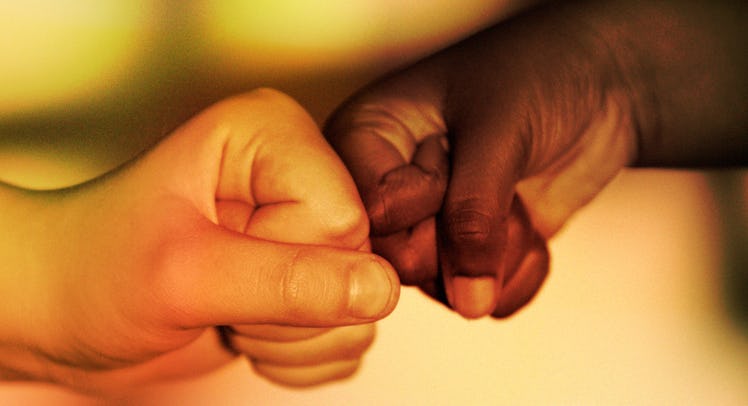New Data Shows How Parents Accidentally Pass on Racial Prejudice to Kids
Study suggests it's not enough to avoid derogatory statements about other cultures. Because kids internalize your biases — even the ones you don't talk about in front of them.

Children learn prejudice from their parents, a new study suggests, and racism hits kids whether or not they hear their dads raging about immigration, hurling invective, or dropping the odd slur. Research found that parents who harbored private, implicit biases against other races appeared to pass those along to their kids as well. The findings suggest that efforts to stamp out racism may be fruitless until adults address their own biases — and that kids may pick up on even subtle hints at prejudice.
“Our research revealed that parents are powerful vehicles of ethnic prejudice transmission towards their children,” co-author on the study Giuseppe Carrus of Roma Tre University in Italy told Fatherly. “Not only through their explicit communications and actions, but also through their unaware and unconscious beliefs, stereotypes and automatic behaviors.”
That’s not to say kids aren’t sort of racist all by themselves. Studies have identified prejudice in children as young as three years old, and even infants seem to prefer faces that match their own ethnicities and people who speak their own languages. Experts agree that an ethnicity bias clearly emerges at around three years of age, peaks in 8-year-olds, and then gradually declines.
The question is how much we should be blaming parents for this bias. A handful of studies have noted strong similarities between the racial attitudes of parents and children, while others have found only weak correlations between racist parents and kids who display ethnic bias. This ambiguity prompted Carrus and colleagues to investigate how parents’ implicit and explicit biases impact their children, with a large sample of 318 white kids between the ages of 3 and 9.
Carrus and his team first asked each parent to respond to 20 statements about ethnic prejudice (“immigrants take our jobs”; “immigrants transmit values not required in our country”). Then, the researchers showed each child photographs of six children from different ethnic groups and asked them to indicate which child he or she “would like to be,” and which child he or she “would like to invite over for a playdate.” This measured each child’s level of implicit bias. Finally, they asked the children to assign adjectives to each photograph, some positive (nice; good; clean) and some decidedly negative (dirty; stupid; bad). This measured each child’s level of explicit bias.
Carrus and colleagues found that parents who displayed high levels of prejudice were significantly more likely to have children who displayed explicit and implicit bias. “Our findings suggest that children’s prejudice may be rooted in the automatic behavior and implicit social influence processes enacted by their significant adults, more than in what parents explicitly think (and likely say) about ethnically different people to their children,” the authors write in the study.
For policymakers, the takeaway is that interventions to prevent bias need to include both parents and children. “Ethnic bias should be contrasted through prevention programs on children and adults,” Carrus says. “Rather than with interventions on ethnically biased children.”
But for parents, the findings have more personal implications. Besides taking pains to avoid explicitly derogatory statements, the study suggests parents who aspire to raise tolerant children need to ensure that they aren’t subtly hinting at their biases in ways that kids internalize. Parents can accomplish this by not “using ‘us vs. them’ expressions,” Carrus suggests, “or by smaller things, such as showing themselves open to talking about other cultures and countries, watching TV and movies from other countries, eating food from other parts of the world.”
“Education to diversity is also a key for overcoming prejudice,” Carrus says. “By transmitting the importance of endorsing universal values of humanity, tolerance, and benevolence in our lives.”
This article was originally published on